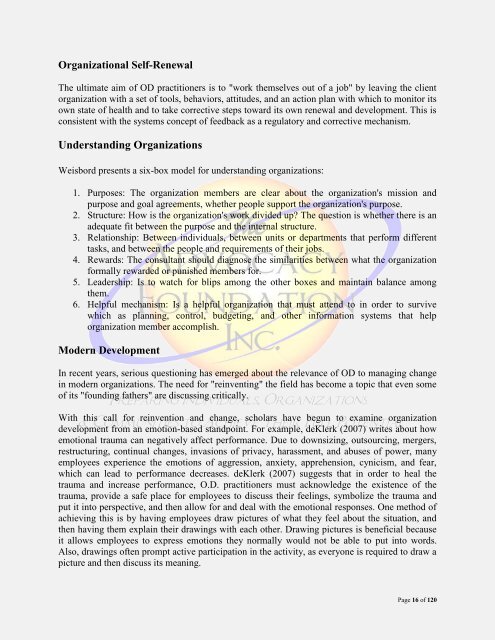Organizational Development - Vol. V, Part II
Organizational Development - Vol. V, Part II
Organizational Development - Vol. V, Part II
You also want an ePaper? Increase the reach of your titles
YUMPU automatically turns print PDFs into web optimized ePapers that Google loves.
<strong>Organizational</strong> Self-Renewal<br />
The ultimate aim of OD practitioners is to "work themselves out of a job" by leaving the client<br />
organization with a set of tools, behaviors, attitudes, and an action plan with which to monitor its<br />
own state of health and to take corrective steps toward its own renewal and development. This is<br />
consistent with the systems concept of feedback as a regulatory and corrective mechanism.<br />
Understanding Organizations<br />
Weisbord presents a six-box model for understanding organizations:<br />
1. Purposes: The organization members are clear about the organization's mission and<br />
purpose and goal agreements, whether people support the organization's purpose.<br />
2. Structure: How is the organization's work divided up? The question is whether there is an<br />
adequate fit between the purpose and the internal structure.<br />
3. Relationship: Between individuals, between units or departments that perform different<br />
tasks, and between the people and requirements of their jobs.<br />
4. Rewards: The consultant should diagnose the similarities between what the organization<br />
formally rewarded or punished members for.<br />
5. Leadership: Is to watch for blips among the other boxes and maintain balance among<br />
them.<br />
6. Helpful mechanism: Is a helpful organization that must attend to in order to survive<br />
which as planning, control, budgeting, and other information systems that help<br />
organization member accomplish.<br />
Modern <strong>Development</strong><br />
In recent years, serious questioning has emerged about the relevance of OD to managing change<br />
in modern organizations. The need for "reinventing" the field has become a topic that even some<br />
of its "founding fathers" are discussing critically.<br />
With this call for reinvention and change, scholars have begun to examine organization<br />
development from an emotion-based standpoint. For example, deKlerk (2007) writes about how<br />
emotional trauma can negatively affect performance. Due to downsizing, outsourcing, mergers,<br />
restructuring, continual changes, invasions of privacy, harassment, and abuses of power, many<br />
employees experience the emotions of aggression, anxiety, apprehension, cynicism, and fear,<br />
which can lead to performance decreases. deKlerk (2007) suggests that in order to heal the<br />
trauma and increase performance, O.D. practitioners must acknowledge the existence of the<br />
trauma, provide a safe place for employees to discuss their feelings, symbolize the trauma and<br />
put it into perspective, and then allow for and deal with the emotional responses. One method of<br />
achieving this is by having employees draw pictures of what they feel about the situation, and<br />
then having them explain their drawings with each other. Drawing pictures is beneficial because<br />
it allows employees to express emotions they normally would not be able to put into words.<br />
Also, drawings often prompt active participation in the activity, as everyone is required to draw a<br />
picture and then discuss its meaning.<br />
Page 16 of 120

















